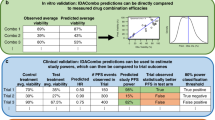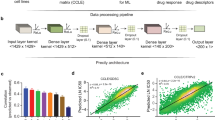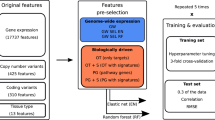Abstract
A cancer drug target is only truly validated by demonstrating that a given therapeutic agent is clinically effective and acts through the target against which it was designed. Nevertheless, it is desirable to declare an early-stage drug target as ‘validated’ before investing in a full-scale drug discovery programme dedicated to it. Although the outcome of validation studies can guide cancer research programmes, strictly defined universal validation criteria have not been established.
This is a preview of subscription content, access via your institution
Access options
Subscribe to this journal
Receive 51 print issues and online access
$199.00 per year
only $3.90 per issue
Buy this article
- Purchase on Springer Link
- Instant access to full article PDF
Prices may be subject to local taxes which are calculated during checkout


Similar content being viewed by others
References
Deininger, M., Buchdunger, E. & Druker, B. J. The development of imatinib as a therapeutic agent for chronic myeloid leukemia. Blood 1, 2640–2653 (2005).
Emens, L. A. Trastuzumab: targeted therapy for the management of HER-2/neu-overexpressing metastatic breast cancer. Am. J. Ther. 12, 243–253 (2005).
Weinstein, I. Addiction to oncogenes: the Achilles Heel of Cancer. Science 297, 63–65 (2002).
Hartwell, L. H., Szankasi, P., Roberts, C. J., Murray, A. W. & Friend, S. H. Integrating genetic approaches into the discovery of anticancer drugs. Science 278, 1064–1068 (1997).
Kaelin, W. J. Jr. The concept of synthetic lethality in the context of anticancer therapy. Nature Rev. Cancer 5, 689–698 (2005).
Farmer, H. et al. Targeting the DNA repair defect in BRCA mutant cells as a therapeutic strategy. Nature 434, 917–921 (2005).
Mills, G. P., Lu, Y. & Kohn, E. C. Linking molecular therapeutics to molecular diagnostics: inhibition of the FRAP/RAFT/TOR component of the PI3K pathway preferentially blocks PTEN mutant cells in vitro and in vivo. Proc. Natl Acad. Sci. USA 98, 10031–10033 (2001).
O'Neill, J., Manion, M., Schwartz, P. & Hockenbery, D. M. Promises and challenges of targeting Bcl-2 anti-apoptotic proteins for cancer therapy. Biochim. Biophys. Acta 1705, 43–51 (2004).
Jensen, E. V. & Jordan, V. C. The estrogen receptor: a model for molecular medicine. Clin. Cancer Res. 9, 1980–1989 (2003).
Jenster, G. The role of the androgen receptor in the development and progression of prostate cancer. Semin. Oncol. 26, 407–421 (1999).
Pitha-Rowe, I., Petty, W. J., Kitareewan, S. & Dmitrovsky, E. Retinoid target genes in acute promyelocytic leukemia. Leukemia 17, 1723–1730 (2003).
Garraway, L. A. et al. Integrative genomic analyses identify MITF as a lineage survival oncogene amplified in malignant melanoma. Nature 436, 117–122 (2005).
Marx, J. Encouraging results for second generation anti-angiogenic drugs. Science 308, 1248–1249 (2005).
van Elsas, A. et al. Relevance of ultraviolet-induced N-ras oncogene point mutations in development of primary human cutaneous melanoma. Am. J. Pathol. 149, 883–893 (1996).
Walker, F. & Olson, M. F. Targeting Ras and Rho GTPases as opportunities for cancer therapies. Curr. Opin. Genet. Dev. 15, 62–68 (2005).
Beeram, M., Patnaik, A. & Rowinsky, E. K. Raf: a strategic target for therapeutic development against cancer. J. Clin. Oncol. 23, 6771–6790 (2005).
Davies, H. et al. Mutations of the BRAF gene in human cancer. Nature 417, 949–954 (2002).
Pollock, P. M. et al. High frequency of BRAF mutations in nevi. Nature Genet. 33, 19–20 (2003).
Thompson, N. & Lyons, J. Recent progress in targeting the Raf/MEK/ERK pathway with inhibitors in cancer drug discovery. Curr. Opin. Pharmacol. 5, 350–356 (2005).
Janne, P. A., Engelman, J. A. & Johnson, B. E. Epidermal growth factor receptor mutations in non-small-cell lung cancer: implications for treatment and tumor biology. J. Clin. Oncol. 23, 3227–3234 (2005).
Paez, J. G. et al. EGFR mutations in lung cancer: correlation with clinical response to gefitinib therapy. Science 304, 1497–500 (2004).
Rao, W. et al. EGF receptor gene mutations are common in lung cancers from “never smokers” and are associated with sensitivity of tumors to gefitinib and erlotinib. Proc. Natl Acad. Sci. USA 101, 13306–13311 (2004).
Tsao, M. S. et al. Erlotinib in lung cancer: molecular and clinical predictors of outcome. N. Engl. J. Med. 353, 133–134 (2005).
Patel, J. D., Pasche, B. & Argiris, A. Targeting non-small cell lung cancer with epidermal growth factor tyrosine kinase inhibitors: where do we stand, where do we go. Crit. Rev. Oncol. Hematol. 50, 175–186 (2004).
Mellinghoff, I. K. et al. Molecular determinants of the response of glioblastomas to EGFR kinase inhibitors. N. Engl. J. Med. 353, 2012–2024 (2005).
Engelman, J. A. et al. ErbB-3 mediates phosphoinositide 3-kinase activity in gefitinib-sensitive non-small cell lung cancer cell lines. Proc. Natl Acad. Sci. USA 102, 3788–3793 (2005).
Shih, C. & Weinberg, R. A. Isolation of a transforming sequence from a human bladder carcinoma cell line. Cell 29, 161–169 (1982).
Silva, J., Chang, K., Hannon, G. J. & Rivas, F. V. RNA-interference-based functional genomics in mammalian cells: reverse genetics coming of age. Oncogene 23, 8401–8409 (2004).
Torrance, C. J., Agrawal, V., Vogelstein, B. & Kinzler, K. W. Use of isogenic human cancer cells for high-throughput screening and drug discovery. Nature Biotechnol. 19, 940–945 (2001).
Kohli, M., Rago, C., Lengauer, C., Kinzler, K. W. & Vogelstein, B. Facile methods for generating human somatic cell gene knockouts using recombinant adeno-associated viruses. Nucleic Acids Res. 32, e3 (2004).
Mazurier, F., Doedens, M., Gan, O. I. & Dick, J. E. Rapid myeloerythroid repopulation after intrafemoral transplantation of NOD–SCID mice reveals a new class of human stem cells. Nature Med. 9, 959–963 (2003).
Brumby, A. M. & Richardson, H. E. Using Drosophila melanogaster to map human cancer pathways. Nature Rev. Cancer 5, 626–639 (2005).
Amatruda, J. D., Shepard, J. L., Stern, H. M. & Zon, L. I. Zebrafish as a cancer model system. Cancer Cell 1, 229–231 (2002).
Simon, J. A. Yeast as a model system for anticancer drug discovery. Expert Opin. Ther. Targets 5, 177–195 (2001).
Hengartner, M. O. & Horvitz, H. R. C. elegans cell survival gene ced-9 encodes a functional homolog of the mammalian proto-oncogene bcl-2. Cell 76, 665–676 (1994).
Kamb, A. What's wrong with our cancer models? Nature Rev. Drug Discov. 4, 161–165 (2005).
Sausville, E. A. Target selection issues in drug discovery and development. J. Chemother. Suppl. 16 (suppl. 4), 16–18 (2004).
Samuels, Y. et al. High frequency of mutations of the PIK3CA gene in human cancers. Science 304, 554 (2004).
Bachman, K. E. et al. The PIK3CA gene is mutated with high frequency in human breast cancers. Cancer Biol. Ther. 3, 772–775 (2004).
Samuels, Y. et al. Mutant PIK3CA promotes cell growth and invasion of human cancer cells. Cancer Cell 7, 561–573 (2005).
Aoki, M., Jiang, H. & Vogt, P. K. Proteasomal degradation of the FoxO1 transcriptional regulator in cells transformed by the P3k and Akt oncoproteins. Proc. Natl Acad. Sci. USA 101, 13613–13617 (2004).
Lengauer, C., Diaz, L. A. & Saha, S. Cancer drug discovery through collaboration. Nature Rev. Drug Discov. 4, 375–380 (2005).
Salloukh, H. F., Vowles, I., Heisterkamp, N., Groffen, J. & Laneuville, P. Early events in leukemogenesis in P190Bcr–abl transgenic mice. Oncogene 19, 4362–4374 (2000).
Lefevre, G. et al. Roles of stem cell factor/c-Kit and effects of Glivec/STI571 in human uveal melanoma cell tumorigenesis. J. Biol. Chem. 279, 31769–31779 (2004).
Mitsiades, C. S., Mitsiades, N. & Koutsilieris, M. The Akt pathway: molecular targets for anti-cancer drug development. Curr. Cancer Drug Targets 4, 235–256 (2004).
Kitayama, H. et al. Neoplastic transformation of normal hematopoietic cells by constitutively activating mutations of c-kit receptor tyrosine kinase. Blood 88, 995–1004 (1996).
Cool, M., Depault, F. & Jolicoeur, P. Fine allelotyping of Erbb2-induced mammary tumors in mice reveals multiple discontinuous candidate regions of tumor-suppressor loci. Genes Chromosomes Cancer 45, 191–202 (2006).
Kang, C. S. et al. An in vitro study on the suppressive effect of glioma cell growth induced by plasmid-based small interference RNA (siRNA) targeting human epidermal growth factor receptor. J. Neurooncol. 73, 267–273 (2005).
Kim, H. & Muller, W. J. The role of the epidermal growth factor receptor family in mammary tumorigenesis and metastasis. Exp. Cell Res. 253, 78–87 (1999).
Early, E. et al. Transgenic expression of PML/RARα impairs myelopoiesis. Proc. Natl Acad. Sci. USA 93, 7900–7904 (1996).
Park, D. J., Vuong, P. T., de Vos, S., Douer, D. & Koeffler, H. P. Comparative analysis of genes regulated by PML/RARα and PLZF/RARα in response to retinoic acid using oligonucleotide arrays. Blood 102, 3727–3736 (2003).
Lewis, J. S. et al. Intrinsic mechanism of estradiol-induced apoptosis in breast cancer cells resistant to estrogen deprivation. J. Natl Cancer Inst. 97, 1746–1759 (2005).
Lu, M., Mira- y-Lopez, R., Nakajo, S., Nakaya, K. & Jing, Y. Expression of estrogen receptor α, retinoic acid receptor α and cellular retinoic acid binding protein II genes is coordinately regulated in human breast cancer cells. Oncogene 24, 4362–4269 (2005).
Yue, W. et al. Tamoxifen versus aromatase inhibitors for breast cancer prevention. Clin. Cancer Res. 11, 9225s–9230s (2005).
Nair, H. B. et al. Induction of aromatase expression in cervical carcinomas: effects of endogenous estrogen on cervical cancer cell proliferation. Cancer Res. 65, 11164–11173 (2005).
Ratliff, T. L. Mutation of the androgen receptor causes oncogenic transformation of the prostate. J. Urol. 174, 1149 (2005).
Tao, J. et al. Inhibiting the growth of malignant melanoma by blocking the expression of vascular endothelial growth factor using an RNA interference approach. Br. J. Dermatol. 153, 715–724 (2005).
Author information
Authors and Affiliations
Ethics declarations
Competing interests
The authors are employed by the Novartis Institutes for BioMedical Research.
Rights and permissions
About this article
Cite this article
Benson, J., Chen, YN., Cornell-Kennon, S. et al. Validating cancer drug targets. Nature 441, 451–456 (2006). https://doi.org/10.1038/nature04873
Published:
Issue Date:
DOI: https://doi.org/10.1038/nature04873
This article is cited by
-
Role of multidrug resistance-associated proteins in cancer therapeutics: past, present, and future perspectives
Environmental Science and Pollution Research (2021)
-
Data-Driven Methods for Advancing Precision Oncology
Current Pharmacology Reports (2018)
-
Citrate Suppresses Tumor Growth in Multiple Models through Inhibition of Glycolysis, the Tricarboxylic Acid Cycle and the IGF-1R Pathway
Scientific Reports (2017)
-
Phosphorylation: Implications in Cancer
The Protein Journal (2017)
-
RETRACTED ARTICLE: One-step Conjugation of Glycyrrhetinic Acid to Cationic Polymers for High-performance Gene Delivery to Cultured Liver Cell
Scientific Reports (2016)
Comments
By submitting a comment you agree to abide by our Terms and Community Guidelines. If you find something abusive or that does not comply with our terms or guidelines please flag it as inappropriate.



